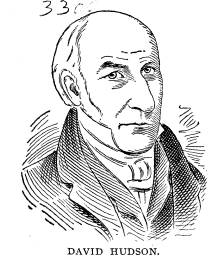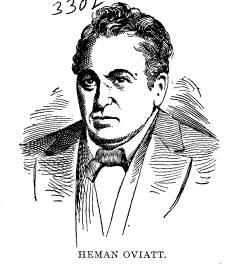Ohio History Journal
|
366 Ohio Arch. and His. Society Publications.
HUDSON CENTENNIAL APPENDIX.
DAVID HUDSON AND HEMAN OVIATT. Hudson is town four, Range ten, and was purchased of the Connecticut Land Company by David Hudson, Birdseye Nor- ton, Nathaniel Norton, Stephen Baldwin, Benjamin Oviatt, and Theodore Parmele, for fifty-two cents an acre. In the original |
|
|
|
Grandequot Bay, on Lake Ontario, Hudson overtook Benjamin Tappan, the owner of Ravenna, with whom he subsequently kept company. In crossing Lake Ontario they overtook Elias Harmon, on his way to Mantua, where he had made a purchase. They then pursued their journey in company and on arriving at the foot of the rapids below Niagara Falls, landed their goods, and drew their boats around the Falls by land. The party at length arrived opposite the mouth of Ashta- bula creek, where they were driven on shore in a storm, and Mr. Harmon's boat stove in. Hudson purchased the wreck for $5, and repaired it, and with Mr. Tappan, proceeded up the lake. On the 8th of June they arrived at the location of Cleveland, |
Hudson Centennial Celebration. 367
then occupied by a population of one
family, Lorenzo Carter,
from Rutland, Vt. Carter had a fine crop
of wheat on the pres-
ent site of the city; and the crop was
worth more than the land
on which it grew.
Hudson's party proceeded up the
Cuyahoga, until they sup-
posed they were in the latitude of
Hudson, when they landed at
the mouth of Brandywine creek, in what
is now the town of
Boston; and after a search of six days,
discovered the southern
line of Hudson.
Mr. Hudson erected a bark shantee and
commenced putting
in a field of wheat, and on the 25th day
of July began the survey
of his township, which he completed on
the 10th of October, and
on the 11th, with his son, Ira, then
only seven years old, he left
his new settlement to return to Goshen,
Conn., for his family.
He took the old wreck, bought of Harmon,
and in this frail
bark started down the lake. At Ontario
county, N. Y., Mr.
Hudson left his little son, and
proceeded alone to Goshen, and
immediately prepared to remove his
family-and in Feb., 1800,
left Goshen to return to his wilderness
home in Ohio. They
stopped at Bloomfield, Ontario county,
N. Y., until spring, dur-
ing which time Hudson purchased four
boats, and thoroughly
repaired the old one, which was now
about to make its third
trip across the lakes. On the 24th day
of April, 1800, they
started up the Mohawk, in their open
boats; the fleet consisting
of "Sloth," Capt. D. Hudson,
"Lion," Capt. Joel Gaylord,
"Beaver," Capt. W. McKinley.
Reuben Bishop, then in his
13th year, was steersman on the
"Duck." From the Mohawk,
they passed down Wood Creek to Oneida
Lake, through the
lake to Oswego River, down that river to
Lake Ontario, up the
lake to the "Falls," round
which they carried their fleet on
wagons. They followed the lake until
they reached the mouth
of the Cuyahoga. On the 28th of May they
reached their land-
ing place at Brandywine creek, where
they made some wooden
sleds, on which to draw their things up
to Hudson.
Elijah Noble, Luman Bishop, David Bishop
and Joseph G.
Bishop, drove the cattle and hogs by
land through the wilder-
ness, and arrived about the time of the
fleet. When collected
for public thanksgiving, as was done
soon after they arrived,
|
368 Ohio Arch. and His. Society Publications.
the company consisted of David Hudson, his wife and six chil- dren, Samuel, Ira, William N., Milo D., Timothy and Abigail L.; Joel Gaylord, Heman Oviatt, Samuel Bishop, Joseph Dar- row, George Crandell, Wm. McKinley, Allen Gaylord, Derick Stafford, Gordon Crandell, Dr. Moses Thompson, Reuben P. Barass, Reuben Bishop, Mrs. Samuel Bishop, Miss Ruth Gay- lord, Mrs. Noble and an infant son. On the 4th of July they celebrated our National Independ- ence, David Hudson delivering the oration; after which all the inhabitants of the town and surrounding country, sat down to a sumptuous repast placed on a table made of bark spread on poles lying in crotched sticks set up in the ground. This table was surrounded by 43 persons, men women and children. Of this party Heman Oviatt deserves special mention owing to the prominent part he took in the establishment not only of Hudson, but also of the town of Richfield. Captain Heman Oviatt was born in Goshen, Litchfield county, Connecticut, September 20, 1775. He was the son of Benjamin Oviatt, who served in the Revolution, enlisting from |
|
|
Goshen. In April, 1800, Heman Oviatt, having caught the "western fever," left Goshen for the West- ern Reserve of Ohio. He left Connecticut on horse- back and traveled till he reached Bloomfield, On- tario county, New York. There he found David Hudson fitting out his sec- ond expedition for Ohio. It was necessary to pur- chase, and take with them, not only their provisions, but all necessary imple- ments for future use in the |
|
western wilds. They proceeded to Lake Ontario (as narrated above) where they bought flat boats called Schenectady Bat- |
Hudson Centennial Celebration. 369
teaux. These boats were built at
Schenectady, taken up the
Mohawk river into Oneida lake, thence
down the Oswego river
to Lake Ontario, thence up the lake to
Grandequot creek, from
which point Hudson and Oviatt and party
embarked. They
started from Grandequot bay for Niagara
river, and proceeded
up the river to the landing below the
falls. Here they unloaded
and carried boats and goods by land
around the falls, launched
and reloaded above the falls, proceeded
to Buffalo and thence
in the open boats up Lake Erie to
Cleveland, or rather to the
mouth of the Cuyahoga river, having no
propelling power but
the muscle of stout arms and "white
ash breeze" (oars) rowing
all the way. Reaching the mouth of the
Cuyahoga, they pushed
their boats up the river to Brandywine
creek, where they landed,
and thence hauled their goods and
provisions on wood sleds
through the woods a distance of seven
miles, to the location of
Hudson, their destination, arriving
there the last of May, 1800.
Here they built themselves log huts and
kept bachelor's hall
through the summer, preparing a place in
the wilderness for their
families. Heman Oviatt located his land
a mile south of the
centre, and he and Joel Gaylord raised a
shantee on the bank of
the creek and put in four acres of
spring wheat. In October,
1800, Captain Oviatt returned to
Connecticut for his family, and
on the 10th of January, 1800, with his
wife and two children,
Marvin and Orson, he left Goshen with a
wagon and team and
two yoke of oxen, which he drove himself
by the way of New
York, Reading and Pittsburg. They
reached Hudson in safety
on the 22nd of March, 1801. From this
time on Heman Oviatt
was intimately connected with the growth
and history of the
town of Hudson. He was a man of great energy, thrift and
pub-
lic spirit; of deep religious
convictions with the stern unflinching
character, cold exterior and rigid
conduct of the Pilgrim fathers.
To the foundation and perpetuity of the
time-honored institution
of learning, known as Western Reserve
College (chartered Feb-
ruary 7, 1826), and located at Hudson,
Heman Oviatt contrib-
uted twelve thousand dollars-in those
days a princely donation.
He was an enthusiastic and liberal
advocate of education, regard-
ing it as not only promotive of good
morals and religious faith,
but of the best citizenship.
370 Ohio Arch. and His. Society Publications.
By the treaty of Fort McIntosh, in 1785,
the Cuyahoga,
Portage Path, and Tuscarawas were the
western boundary of
the United States. This was confirmed by
what is called
Wayne's Treaty, made at Greenville,
August 3, 1795, when the
chiefs of twelve tribes were present,
and ratified it. The land
on the west side of the Cuyahoga was not
purchased till 1805,
when the United States acquired it by
the treaty of Fort Industry,
on the Maumee.
Richfield being town four, in range
twelve, was consequently
west of the Cuyahoga, and became a part
of the United States
by the Treaty of Fort Industry in 1805,
or by what was known
in those days as "the new
purchase." In the conveyance of
"the Western Reserve" to the
State of Connecticut, and by the
State of Connecticut to "the
Connecticut Land Company," Rich-
field in "the Drafts," fell to
four proprietors. Benjamin Tall-
madge drew the N. W. quarter, Capt.
Smith the S. W. quarter,
a family by the name of Green the S. E.
quarter, and Uriel
Holmes the N. E. quarter township
containing 16,000 acres.
In 1811 Capt. Heman Oviatt returned to
Connecticut, and
in an interview with Col. Tallmadge, the
Colonel expressed
great fears of a war with England, and
that one consequence
would be the loss of our western
territory. Capt. Oviatt had
greater faith in the American Republic
and inquired what the
Colonel would take for his lands, when
the Colonel offered them
for $1.25
per acre. Capt. Oviatt agreed to give it,
and thus be-
came the owner of one-fourth of the
township. He subsequently
took his father, Benjamin, and brother,
Nathaniel, into partner-
ship in the speculation, and in the fall
of that year Nathaniel
moved onto the Richfield land.
Captain Oviatt continued to reside in
Hudson till 1836, when
he removed to Richfield with the history of which he was iden-
tified till his death, December 5, 1854.
Eunice Newton, daughter of Isaac Newton
and grand-
daughter of John Newton, all of Goshen, Connecticut,
where she
was born, November 15, 1777, and married
to Heman Oviatt,
June 10, 1797, was one of the most
remarkable women among the
first settlers of the Western Reserve.
She possessed extraordi-
nary fortitude, bravery and presence of
mind, and very many are
Hudson Centennial Celebration. 371
the accounts of her acts of kindness to
the Indians and of cour-
age in encountering the perils of
frontier life. Among the Red
men she won many firm friends, who in
numerous instances ren-
dered her inestimable service, indeed in
two or three cases pro-
tected her life. She was a woman of
varied accomplishments,
and would have graced any sphere of
life. She spoke three
Indian languages fluently, Chippeway,
Seneca and Delaware.
Her regard for fidelity was very strict.
She considered all
verbal engagements between man and man,
whether they were
white or red, as sacred. She died
September 13, 1813, at Hud-
son, Ohio. Heman Oviatt subsequently
married Sophia Elmira
Kilbourne, and upon the death of the
latter married a Mrs. Cur-
tiss, of Akron.*
* An interesting recital of some of the
pioneer experiences of Heman
Oviatt and Eunice Newton Oviatt, in the
Western Reserve frontier, is
preserved in the history of the Newton
and Oviatt families, written
(1875) by Mrs. Harriet Oviatt Randall
(b. Hudson, May 26, 1808, d.
Columbus, September 12, 1885), daughter
of Heman Oviatt and Eunice
Newton (above) and wife of Rev. D. A.
Randall, D. D. (b. January 14,
1813, Colchester, Conn., d. June 27,
1884, Columbus, Ohio), son of
James and Joanna (Pemberton) Randall and
grandson of John Randall
and of Patrick Grant Pemberton, both
Revolutionary soldiers in the
Connecticut Volunteers. For much of the
above data we are indebted
to the "Historical Reminiscences of
Summit county," by Gen. L. V.
Bierce (Akron, Ohio, 1854).-E. 0.
R., Editor.

